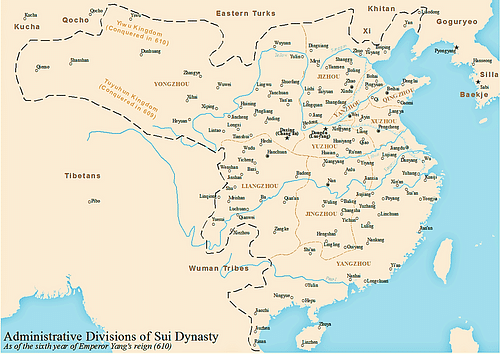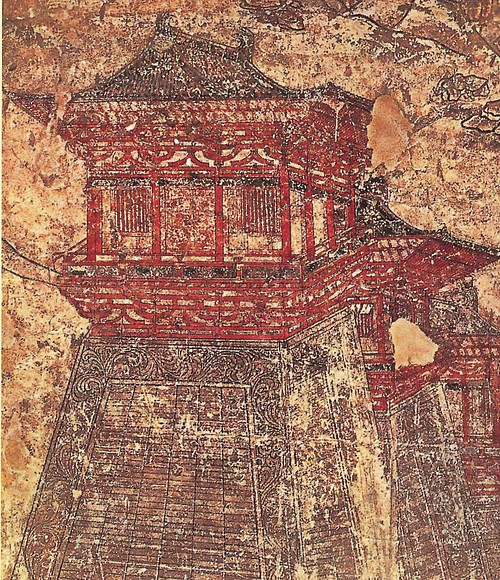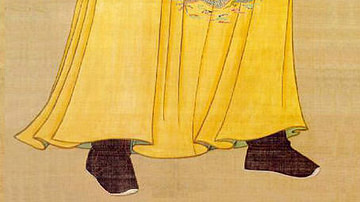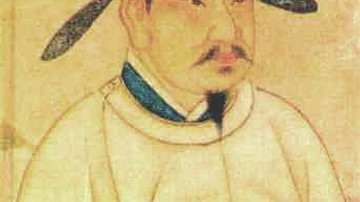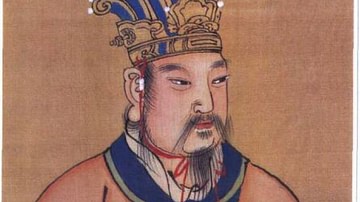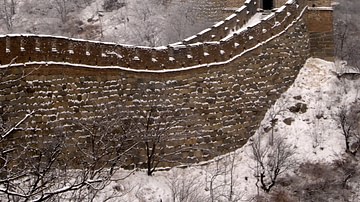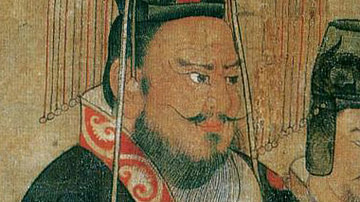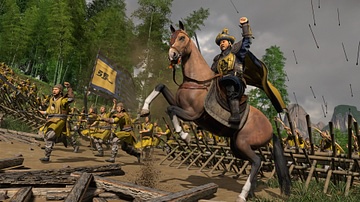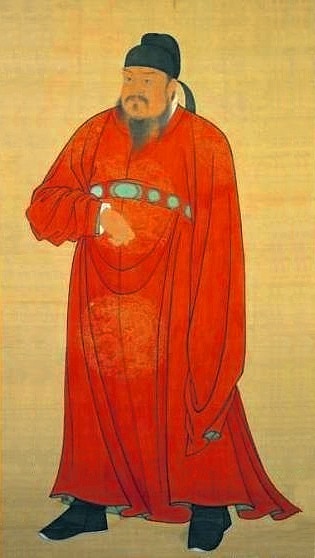
Emperor Gaozu (also Kao-tsu, formerly Li Yuan, r. 618-626 CE) was a Sui military commander who led a rebellion against his former masters, seized control of the state, and founded the Tang Dynasty (618-906 CE). Overshadowed in the ancient history books by his son Taizong, who succeeded him as emperor, Gaozu was, nevertheless, responsible for unifying China and laying the political, social, and economic foundations for one of the golden eras of Chinese history.
The Fall of the Sui
The Sui dynasty had ruled China since 581 CE, but already by the early 7th century CE, the Sui were facing seemingly insurmountable problems to their reign. A Sui expedition had met with disaster in 598 CE when it attacked the kingdom of Goguryeo (Koguryo) in Korea and northern Manchuria. The Chinese ran out of supplies, hit heavy rains, and had to return home. A second invasion was launched in 611 CE, this time by sea but was destroyed in a storm. Going for third time lucky, the Sui attacked again in 612 CE, but Goguryeo won a resounding victory at the Battle of Salsu River. According to legend, of the 300,000-strong Sui army, only 2,700 ever returned to China. Two more attacks were rebuffed in 613 and 614 CE.
The lack of victories in Korea could be blamed on no one else but the commander who had led them, Emperor Yangdi, and the consequent hardships endured by the Chinese peasantry in terms of service and taxation led to widespread rebellion in 613 CE. The situation was only fuelled by more military losses, this time to the Eastern Turks, and the emperor's reputation for excessive spending and a debauched lifestyle. The Chinese government would be taken over by one Li Yuan, later to be known as Emperor Gaozu.
Early Career
Li Yuan was born in 566 CE. A Duke of Tang with family connections in the imperial household and some Turkic roots, he was able to rise to a prominent position in the Sui administration. Yuan started his career as one of Emperor Wendi's (r. 581-601 CE) personal bodyguards, and he soon became a close favourite of both the emperor and his consort Empress Wen-hsien. Taking on roles as prefect and governor in several cities and regions, Yuan acquired additional ceremonial posts at court. He was made vice-president of the Imperial Household Department during the reign of Wendi's successor, Emperor Yangdi (r. 604-618 CE). In 613 CE Yuan was made vice-president of the Court of Imperial Insignia which meant he was in charge of the capitals arsenal. Part of his responsibilities was the sending of arms to the army invading Korea.
Li Yuan Becomes Emperor
Floods, conscription in the army, or compulsory labour in the state building projects had all taken its toll on the peasant population. Nine rebellions swept the kingdom between 613 and 614 CE, and although all were ruthlessly put down, rebel soldiers still roamed at will and Sui authority was dangerously weak in several regions. Yuan was given the task in 615 and 616 CE of clearing the Ho-tung (modern Shansi province) of bandits. The general also managed to repel Turkic border raids there.
Yuan, made the military commander at Taiyuan after his exploits in Ho-tung, set up his headquarters at Chin-yang. With much of the northern territories now no longer under Sui control, Yuan was encouraged by his supporters to seize power himself and restore some semblance of order. Yuan saw that the time was ripe for the Sui regime to be toppled, and so, at the age of 51, he made his move and led the 617 CE rebellion.
Making himself supreme above the other warlords who controlled various territories across the kingdom with a series of alliances, false promises, and gratifications, Yuan proved himself much more than a gifted general. He had first guaranteed the northern frontier by making a deal with the eastern Turks, promising them future booty in return for men, horses, and weapons. Convinced by a deceptively worded letter that Yuan intended to make his new state a vassal to their own, they gave him 2,000 horses and 500 soldiers for his cause.
Thus bolstered, Li Yuan set off with his army - now numbering some 30,000 men - to attack the Sui capital at Ta-hsing ch'eng. On the way, the army defeated several Sui forces and was swelled by the addition of more rebels and bandits, including a large force led by his well-connected daughter Lady Li. The Tang army now numbered 200,000, and the capital was besieged for five weeks and then taken in November 617 CE. Emperor Yangdi had already fled, and Yuan put on the throne in his place a puppet emperor, the young Yang Yu (title: Kung-ti). Many of Yuan's followers were opposed to this and called for their leader to make himself the emperor of a new dynasty. When Yuan conquered the eastern capital of Luoyang he did just that, declaring himself emperor in 618 CE and his new kingdom Tang after his family fiefdom.
Yuan's next task was to set about quashing all dissent to his rule across the country by whatever means suited the occasion. Alliances, amnesties, rewards, court titles, and, surprisingly rarely, brute force, were all used so that by 624 CE, Emperor Gaozu, as Li Yuan would become known, had established control of China. Ta-hsing ch'eng remained the capital but was renamed Chang'an after the old Han capital. Appropriately enough, Gaozu selected the following name for his reign: “Military Virtue”.
Administrative Reforms
Taizong, the Tang's second emperor, would largely be the figure given most credit for establishing the Tang dynasty in traditional Chinese histories, but a re-examination of neglected contemporary records by modern historians has sought to rebalance the biased and often fabricated accounts which minimised Gaozu's role in taking power and forming the dynasty. Gaozu first set about bolstering the defence of China's northern borders against further Turk attacks. Then he took important steps to centralise government and increase its efficiency, albeit using a good number of the same personnel who had previously held positions of responsibility under the Sui. This provided much-needed continuity and government experience to the new dynasty but also ensured the old elite had a vested interest in its continuance.
The three main ministries of the Secretariat, Chancellery, and Department of State Affairs were maintained, but the high degree of overlap between them was minimised. In the new system, after a short period of confusion where Gaozu himself often intervened, the Secretariat drafted edicts, the Chancellery reviewed and amended them, and the Department of State Affairs was charged with putting them into practice. Another development was that Gaozu ensured all regions were represented by officials at the highest level.
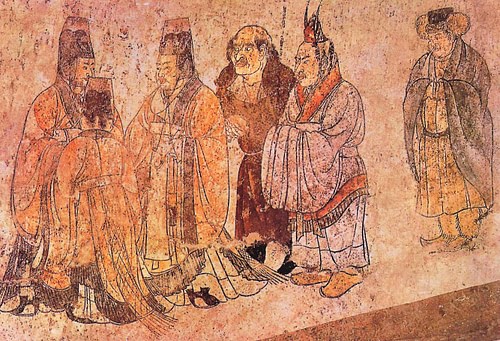
Gaozu relaxed the harsh law code of the Sui and began the process of replacing them with a more codified and detailed system of records, especially for the state administration. Land reforms were made to increase tax revenues, which were made more uniform across the country. He continued the Sui policy of improving the country's irrigation and transport networks, notably irrigating 80,000 acres with diverted waters from the Huang-ho River in 624 CE. The state actively promoted education and preparation for the reinstated civil service entrance examinations. A new coinage was minted from 621 CE in an effort to battle the massive counterfeiting that had gone on under the Sui. All markets across China were supervised by an appointed official who controlled such matters as official weights and measures as well as inspecting the quality of goods on sale and their prices - consumers had never had it so good.
In the area of religion much was as before, with Buddhism, Taoism, and Confucianism dominating. The number of Buddhist temples was limited as this “non-Chinese” religion was thought by many officials to be becoming too powerful for their own good. Similarly, Taoist temples were controlled and their numbers limited, too. Most of these measures against the monasteries though would be reversed by Gaozu's successors. Finally, a more peaceful strategy was adopted towards Goguryeo with the Korean state offering tribute and Chinese captives from the Sui campaigns. Goguryeo was, no doubt, quick to realise that China was back on its feet again and a powerful dynasty was in the making.
Successor & Legacy
As an able administrator who surrounded himself with equally gifted advisors Gaozu, then, laid the groundwork on which his highly successful dynasty would stand until its fall 300 years later in 907 CE. Yuan was not to leave any succession to chance, either, as he had 22 sons, but it was his second son Li Shimin who become his successor as Emperor Taizong in 626 CE. Li Shimin was not actually Gaozu's first choice, but as he murdered his elder brother and had huge prestige from his military exploits in his father's campaign against the Sui, he was able to push himself forward as the only viable candidate. Such was his power at court that Li Shimin even forced his father to abdicate in his favour and take on the merely honorary title of Retired Emperor. Taizong would go on to become one of China's most revered emperors, but his criminal and political manoeuvres to gain the throne set a dangerous precedent - a problem which beset many of the Tang dynasty's subsequent rulers and their children.
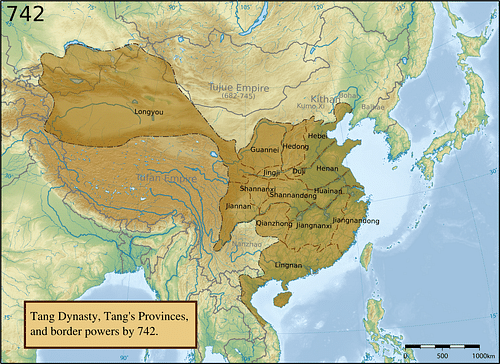
Gaozu was not without his critics amongst the Chinese historians of subsequent periods, as we have seen in regard to his role as founder of the Tang state apparatus. Other criticisms aimed at him was that he was rather too fond of hunting and musical entertainment than was proper for a good ruler who should follow the classic principles of Confucianism. It was said he made decisions on a whim, was guilty of nepotism, or listened too much to his lady entourage, and once scandalously gave an official post to a favourite musician. As the historian H. J. Wechsler reminds us, though,
These character traits, however, should not be allowed to obscure his solid and impressive achievement: the re-establishment of a strong and highly centralised state which endured for almost three centuries. Under Gaozu the Tang successfully established political, economic and military institutions which became the hallmarks of the Tang age, which in many cases continued to influence deeply Chinese civilization down to the present century, and which provided the basic institutional models for the newly emergent states of Chinese-dominated east Asia - Japan, Korea and Vietnam. (in Twitchett, 169)
